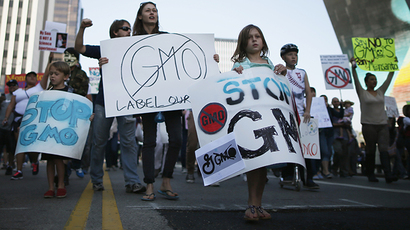Genetically engineered trees under USDA consideration could harm environment - report

As the US Department of Agriculture considers whether to authorize the unrestricted planting of genetically engineered Eucalyptus trees experts are warning that such a policy would not only be unnatural, but negatively impact the environment.
The GE tree is primarily developed by ArborGen, a biotechnology corporation that has been met with protests in recent months, to provide materials to create paper and the wood pellets that fuel power plants around the world. Despite the trees’ propensity for cooler climates, ArborGen has sought to promote the trees’ growth in the south eastern US under the notion that they will help the environment sustain itself.
Yet a new report from the Center for Food Safety titled “Genetically Engineered Trees: The New Frontier of Biotechnology” details how GE trees could increase greenhouse gas emission and reduce biodiversity.
“Commercializing GE trees could be devastating to the environment,” Debbie Barker, international program director for the Center for Food Safety, told Eco Watch. “Factory forests’ will accelerate and expand large-scale, chemical-intensive, monoculture plantations. We need to understand the risks in order to determine if GE trees are a sustainable way forward or a dangerous diversion.”
Among the concerns laid out in the report is the immediate risk GE trees would pose to natural trees in the surrounding area. Not only are they expected to suck up at least twice as much water as normal trees, but GE trees are also known for their ability to spread seeds and pollens over great distances. If wild trees become contaminated they could be more vulnerable to pests and pathogens, thus risking the life span of natural US forests. The GE trees would also require substantial amounts of fertilizers and pesticides as well.
“Eucalyptus is the first forest tree now being considered for approval for unrestricted planting, but some of the largest biotechnology, paper and energy corporations are experimenting on pine, poplar, chestnut and several varieties of fruit,” said Barker, who also edited the report.
Despite these and other warnings, biotech corporations have a strong incentive to argue against any environmental objections. If GE eucalyptus is approved, according to Eco Watch, ArborGen expects that company profits will explode from $25 million to $500 million in just five years.
Another red flag for the Center for Food Safety is the assertion that burning wood pellets slows climate change. The report acknowledges that the method, which involves selling European stumps to European companies so they can keep power plants running 24 hours a day, helps cut down on the number of sulfur emissions. But more recent research has found that burning wood pellets likely increases the presence of other pollutants.
The USDA will consider the adoption of GE tree planting despite what environmental advocates say are scientific risks, and questions about the integrity of government’s scrutiny over ArborGen.
Rachel Smolker, co-director of the environmental advocacy group Biofuelwatch, wrote a column in The Huffington Post earlier this year alleging that vested commercial interests made rigorous evaluation of the biotech’s venture unlikely.
“Perhaps in part it is a response to the fact that ArborGen has succeeded in placing key personnel within positions in agencies such as the USDA and Department of Education where these decisions are made also,” she wrote. “Also, it is clear that the entire awesome weight of the biomass juggernaut comes into play.”
“Subsidies are flowing into the construction of hundreds of bioenergy ‘renewable energy’ projects, including plans to convert massive coal plants to burn biomass, efforts to convert wood into ethanol and other transport fuels, as well as a suite of other biomass based chemicals and products,” Smolker continued. “The demand, and the potentially massive profits to be made, are altogether clear.”














